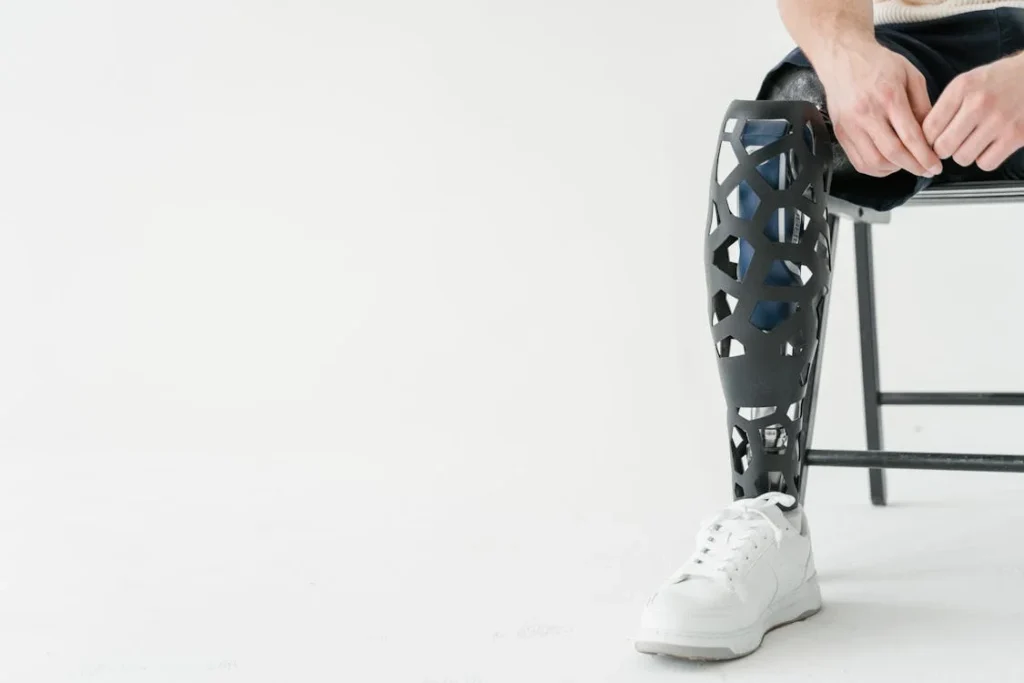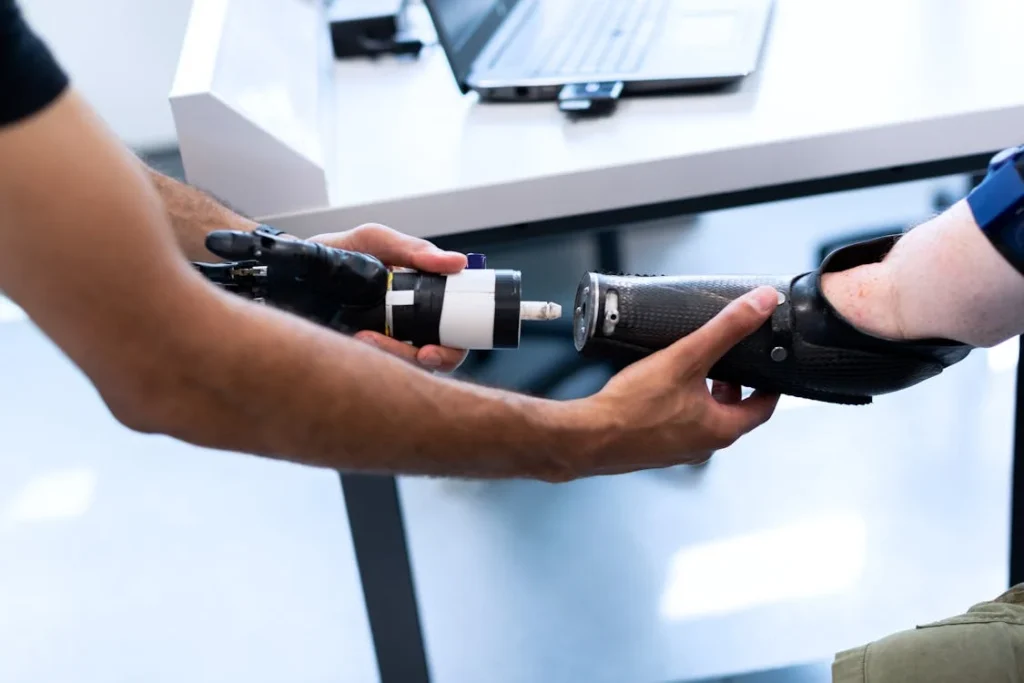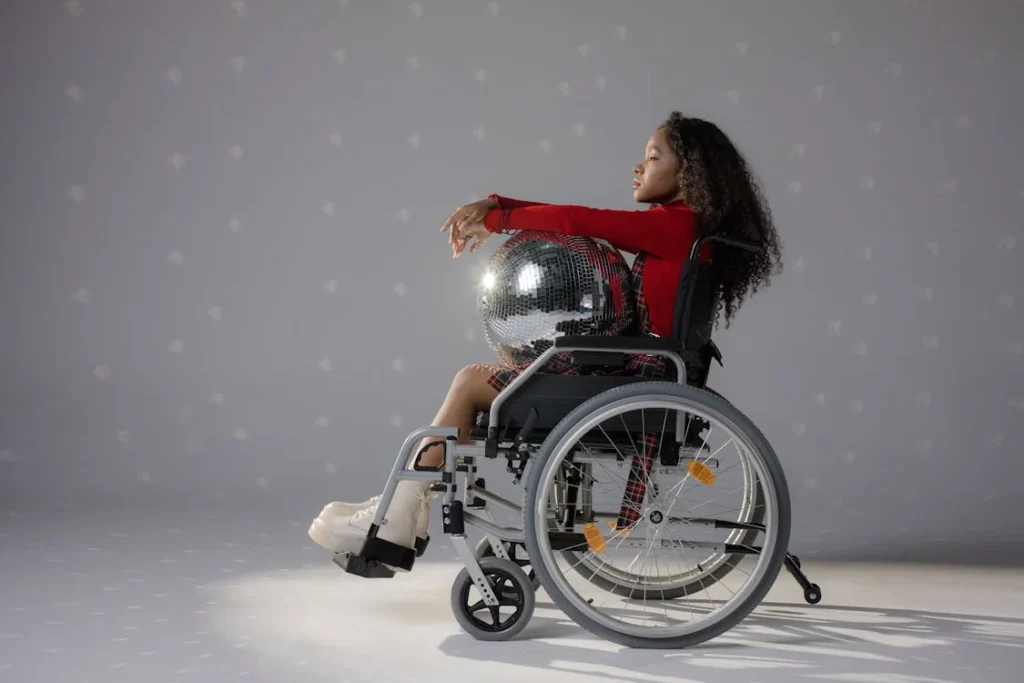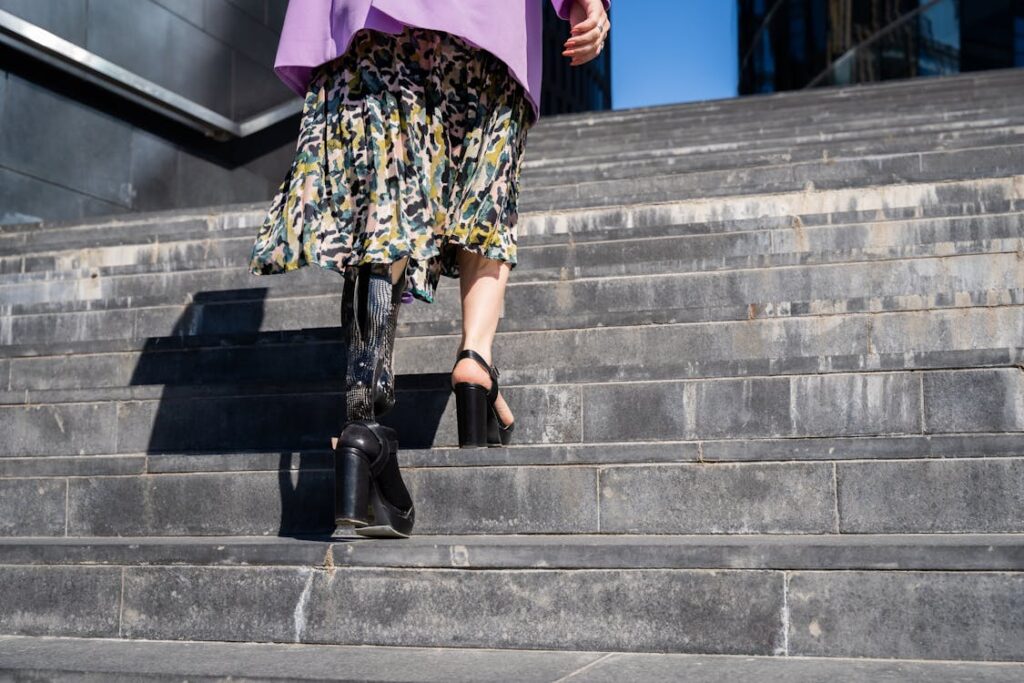Losing a limb changes a person’s life in many ways. It’s not just about movement—it’s about how someone feels, lives, and adjusts to a new normal. While prosthetic limbs offer a path forward, learning how to use them every day is a journey, not a quick fix. That’s where occupational therapy steps in—not just as support, but as a partner in this life-changing process.
Occupational therapy isn’t about helping people get back to who they were before. It’s about helping them move forward with confidence, purpose, and the skills they need to live life fully again. Whether it’s brushing teeth, cooking dinner, typing on a keyboard, or holding a cup of tea, these small actions shape how independent and whole someone feels.

Understanding the Connection Between the Mind, Body, and Prosthetic
When someone receives a prosthetic limb, it isn’t just about replacing what was lost. It’s about relearning how to live with something entirely new.
The prosthetic is a tool, yes—but it only works well when the body and mind accept it and adapt to it. This is where occupational therapy starts playing a powerful role, right from the beginning.
It Begins With Trust
For many people, the first few weeks after getting a prosthetic are full of mixed emotions. Some feel excitement and hope. Others feel frustration, fear, or even anger. All of these emotions are completely natural.
Occupational therapy doesn’t rush this process. Instead, it focuses on building a sense of trust—trust in the therapist, trust in the process, and most importantly, trust in the body’s ability to change and learn again.
This trust is not built overnight. Therapists take time to talk, listen, and understand the person’s lifestyle, personality, habits, and emotional triggers. Before any exercises or training begin, there’s a deep understanding that must be created.
If someone feels emotionally safe and heard, they are far more likely to embrace the work that follows.
Teaching the Body to Learn Again
Our brains have a natural ability called neuroplasticity. This means they can adapt, form new pathways, and learn new ways of doing things. When someone loses a limb, the brain has to change how it thinks about movement.
For example, picking up a spoon or tying shoelaces with a prosthetic hand is not automatic. The brain needs to be retrained to see the prosthetic as part of the body, not as something separate or foreign.
Occupational therapists guide people through this learning process in small, thoughtful steps. At first, it might be just holding a toothbrush or feeling the weight of the prosthetic arm while sitting still.
Slowly, the brain begins to accept the limb, and the body begins to find its balance again. This stage often involves a lot of trial and error, but it’s where the most powerful growth happens.
Creating a Routine That Works in Real Life
Every person has their own way of living. Someone who enjoys cooking will have different challenges compared to someone who works on a computer all day. T
hat’s why occupational therapy is never one-size-fits-all. Instead, therapists work with individuals to understand how they spend their day and what tasks matter most to them.
Then, the therapist builds a plan around those needs. If tying shoelaces is important, that becomes a focus.
If holding a pen or applying makeup is part of someone’s daily life, then the exercises and routines are designed to help with exactly that.
These are not generic movements—they are highly personalized strategies to make sure the prosthetic becomes a useful, everyday tool.
Therapists often simulate real-world situations in the clinic. Someone might practice getting dressed, walking on different surfaces, or using the kitchen.
These sessions are hands-on and realistic, so people can build confidence not just inside a therapy room, but also in their own homes and neighborhoods.
Understanding the Emotional Roadblocks
Many people believe that therapy is only physical. But in truth, emotional healing is just as important. It’s common for people to feel overwhelmed, especially when progress feels slow or when a small task becomes frustrating.
This emotional weight can lead to self-doubt, anxiety, or even depression.
Occupational therapists are trained to recognize these signs. They offer emotional support, gentle encouragement, and practical tips to reduce frustration.
For example, if brushing hair with a prosthetic hand feels impossible, the therapist might suggest an alternative technique or tool that’s easier to use. This isn’t just about solving a problem—it’s about helping someone feel successful, even in the small moments.
And when a person feels capable in one area, it often creates a ripple effect. They start to believe in themselves more. They become more open to challenges. This change in mindset can be the most powerful part of therapy.
The First Taste of Independence
There’s a moment in therapy when everything begins to click. It might be the first time someone uses their prosthetic to drink water without spilling.
Or it could be walking up a flight of stairs on their own. These are the turning points—the moments where the hard work pays off.
Occupational therapy builds toward these wins. It teaches people to expect challenges, yes, but also to trust that they can overcome them.
And when they do, the feeling is nothing short of freedom. It’s a reminder that their life isn’t defined by what they lost, but by what they’ve learned and how far they’ve come.

Early Intervention: Why Timing Matters More Than You Think
One of the most important things about occupational therapy is that it works best when it starts early. The sooner therapy begins after amputation and the prosthetic fitting process starts, the smoother the transition becomes.
Early intervention sets the stage for success because it helps the body and mind adjust before bad habits form. It also keeps motivation high during a time when people are most vulnerable.
Building Skills Before the Prosthetic Arrives
Many people think that occupational therapy starts only after they receive their prosthetic. In reality, it often begins much earlier. Even before the prosthetic is fitted, therapists help individuals strengthen their remaining muscles, improve flexibility, and maintain balance.
This stage is crucial because a prosthetic requires the whole body to work together. A strong core and a balanced posture can make a huge difference in how comfortably and effectively someone uses their prosthetic.
This time is also used to teach techniques that will make future learning easier. For example, therapists might work on body awareness, energy conservation, or teaching people how to shift weight safely.
All of these things prepare someone mentally and physically for the changes that come with wearing a prosthetic limb every day.
Helping People Adjust to Sensations and Movement
When someone first wears a prosthetic, they often notice that it feels strange, heavy, or even awkward. These sensations can be distracting or even frustrating. Occupational therapists help people get used to these feelings gradually, so the body begins to accept the new limb as normal.
This can involve simple exercises like wearing the prosthetic for short periods, then increasing the time slowly as comfort improves.
Therapists also help with teaching safe movement patterns. This can involve simple things like learning to reach without overextending, or how to use the prosthetic while maintaining good posture.
Small adjustments like these can prevent pain and injury later on. Over time, the awkwardness fades, and the prosthetic begins to feel like a natural part of daily movement.
Training for Function, Not Just Motion
There’s a big difference between moving a prosthetic and using it effectively. Occupational therapy focuses on function—how someone can use the prosthetic in a way that truly supports their lifestyle.
It’s not just about lifting a spoon; it’s about feeding oneself. It’s not just about grabbing a handle; it’s about opening the door to independence.
Therapists work on real-world scenarios that reflect each person’s routine. If someone wants to ride a bicycle again, therapy might include balance training and hand control.
If someone is going back to work in an office, therapy might involve typing, holding papers, or using a phone. Every task is broken down, practiced with care, and built into a habit that the person can rely on.
This approach helps people focus on the outcomes that matter to them, rather than just the motions. And when tasks are meaningful, people are more motivated to practice and improve.
Handling Setbacks Without Losing Progress
Progress in occupational therapy is not always a straight line. Some days are easier than others. Some tasks that seemed simple yesterday might feel impossible today.
This is a normal part of recovery. What matters most is how people deal with those setbacks.
Therapists play a key role in helping people stay grounded during tough times. They offer reassurance, adjust goals, and suggest new techniques that reduce pressure while still moving forward.
For example, if someone is struggling to use a prosthetic fork while eating, the therapist might suggest a differently shaped handle, a slower pace, or a new sitting posture that offers better control.
The goal is never perfection. The goal is steady progress, confidence, and the ability to bounce back after difficult moments.
Strengthening the Support System
Occupational therapy doesn’t happen in isolation. It works best when family members, caregivers, and even employers are part of the journey. That’s why therapists often include loved ones in some sessions.
They explain how to assist without taking over, how to offer encouragement, and how to make small changes at home that support independence.
Something as simple as adjusting the height of a chair, rearranging items on a shelf, or using a different type of light switch can make a big difference.
These changes remove unnecessary obstacles and make daily routines smoother for the person using the prosthetic.
When the environment is supportive, both physically and emotionally, therapy becomes more effective. The person feels less alone, more empowered, and more willing to take on new challenges.

Daily Integration: Turning Practice Into Lifestyle
After someone becomes more comfortable with their prosthetic and begins to use it regularly, the next big step is integrating it into their lifestyle. This part of the journey isn’t about learning how to use the prosthetic—it’s about using it without having to think so hard about it.
It’s about making the use of the prosthetic as natural as brushing teeth, tying shoelaces, or picking up a coffee mug. And this is where occupational therapy quietly works in the background, helping turn practice into habit, and habit into second nature.
Starting the Day With Purpose
One of the simplest but most powerful ways therapists support prosthetic users is by helping them build strong morning routines.
A morning routine is often the first time in the day when a person interacts with their prosthetic, and setting a positive tone here can shape the rest of the day.
For someone with a new prosthetic leg, this might mean practicing how to sit up in bed, stand up safely, and walk to the bathroom with good posture and stability. For a person with a prosthetic arm, it could be about putting on clothes, using the hand to hold a toothbrush, or opening a toothpaste tube.
These actions, though small, hold emotional weight. They tell the brain, “I can do this.” They also give the person a sense of ownership and control over their day. That confidence often carries over into more complex tasks as the day goes on.
Working With Real-World Challenges
As daily use becomes more regular, new challenges often come up. These can be very specific to someone’s home, work, or social life. Maybe the door handles in their house are difficult to grip.
Maybe they need to carry a bag while using a prosthetic hand. Maybe they want to cook but struggle to hold a pot steady with one arm.
Occupational therapists don’t just teach broad techniques—they observe and adjust to each person’s environment. If someone can’t hold a pan securely, the therapist may introduce a tool to support it or teach a safer grip technique.
If a person struggles with typing, they might explore new hand positions, devices, or even alternative input methods like voice typing. Every challenge is met with a solution, and each solution is practical, realistic, and tested in real time.
This problem-solving approach helps people feel more prepared and less anxious when facing new tasks. It removes the feeling of helplessness and replaces it with a quiet, growing sense of ability.
Maintaining the Prosthetic Through Routine Habits
Using a prosthetic daily also means taking care of it. Occupational therapists spend time teaching people how to maintain their prosthetic properly.
This includes cleaning, checking for signs of wear, understanding how to adjust straps or fittings, and knowing when to contact their prosthetist for support.
These routines are often built into the person’s schedule so that they don’t feel like a burden. A few minutes at the end of the day to inspect and clean the device can prevent larger issues down the line, such as skin irritation or mechanical failure.
The goal is to make maintenance feel as natural as washing one’s face or brushing teeth—not a chore, but a part of caring for oneself.
Therapists may also teach people to pay attention to their bodies. If there’s discomfort, pressure, or skin damage, the body is sending a message.
Learning to listen to that message and act on it—before it turns into a serious issue—is part of the education that occupational therapy provides.
Energy Management and Avoiding Fatigue
Using a prosthetic can take more energy than people realize, especially in the early stages. Simple tasks like walking across the room or standing in line can feel tiring. This can lead to frustration or burnout if not managed well.
Occupational therapists teach energy conservation techniques to help people balance their effort throughout the day. This might mean learning to sit down while doing certain tasks, pacing activities to allow for rest breaks, or planning the day in a way that heavier tasks are spaced out.
These strategies are especially helpful for people returning to work or school, where long hours and high activity levels can quickly drain energy.
Therapists also monitor signs of overuse or poor posture, which can lead to long-term physical problems if not corrected early.
They teach how to use the body in the most efficient way, which protects joints, reduces stress on muscles, and improves comfort.
Rediscovering Hobbies and Leisure
Once the basics of daily life are under control, many people want to return to hobbies they once loved—or explore new ones.
This is an important step in recovery because it’s not just about function anymore. It’s about joy, expression, and identity.
Occupational therapists help make this possible. If someone used to paint, the therapist helps find a way to hold a brush with a prosthetic.
If someone wants to go hiking, the therapist prepares them to walk on uneven ground. The point is not just to make leisure possible—it’s to make it meaningful again.
People often feel a deep sense of loss when they can’t do the things they love. Rebuilding that connection is a turning point. It brings back a part of their personality that may have felt buried.
And when they experience success, even in something small, it strengthens their belief in what else might be possible.

Returning to Work and Community Life With Confidence
When someone feels ready to return to work, school, or take part in their community again, it’s a big step. It’s not just about physical ability anymore—it’s about how they see themselves, how others respond to them, and whether they feel truly included.
This is where occupational therapy moves into one of its most powerful roles: helping people bridge the gap between recovery and real-world reintegration.
Planning for a Return to Work
Going back to work after getting a prosthetic is a goal for many, but it comes with new questions. Can they perform their tasks as before? Will their colleagues understand? How will they manage their energy during a long workday?
Occupational therapy looks at all of these questions with care and helps create a plan that suits the person’s job, pace, and physical needs.
Therapists begin by understanding the person’s work environment and job role. If it’s an office job, they might focus on computer tasks, sitting posture, and hand coordination.
If it’s more physical work, the plan might include safe lifting, walking over different surfaces, or using specific tools.
Occupational therapists also help people talk to their employers if needed. They guide on how to ask for small but helpful changes, like adjusting a chair, switching to voice-activated software, or having a flexible break schedule.
These are called “reasonable accommodations,” and they can make all the difference between surviving at work and thriving there.
Work readiness training may even include mock job scenarios. These simulations help people feel less anxious and more prepared.
That kind of practice helps build calmness in real situations, especially when someone is worried about judgment or performance.
Dealing With Social Perceptions
A big part of going back into the world is facing how others might react. For many people using prosthetics, this can be emotionally challenging.
Some fear being stared at or treated differently. Others worry that people will only see their prosthetic and not their personality or skills.
Occupational therapy doesn’t ignore this emotional layer. Therapists work with individuals to rebuild confidence and handle social situations with more ease. They may help someone rehearse what to say if a stranger asks questions.
They might talk through past experiences where someone felt embarrassed or isolated, and then work together to reframe that experience in a way that feels less painful.
This emotional work is deeply personal. For some people, humor is a coping tool. For others, it’s knowledge—feeling more in control when they can explain their device.
Occupational therapy creates space for all of these feelings. It validates them, and then helps the person find their own way of dealing with them.
Improving Public Navigation Skills
Using a prosthetic outside the home brings new challenges. Buses, stairs, crowded streets, slippery sidewalks—these things can feel overwhelming when someone is still learning. Occupational therapists help break these barriers down.
They might start by walking with the person through different environments—first a hallway, then a staircase, then a short walk outside. Every time, the therapist observes and gives tips.
Maybe the person is putting too much weight on the prosthetic. Maybe they’re turning their hips too fast. Every little movement matters, and small tweaks can lead to big gains in comfort and safety.
Therapists also focus on how to deal with the unexpected. What happens if a bus comes late and someone has to stand longer than expected? What if it rains and the floor gets slippery? Practicing these moments makes them less scary. When someone knows what to do, they feel stronger—and that strength shows.
Building a Personal System of Independence
By this stage, occupational therapy shifts from being hands-on to being more about guidance and strategy. The person knows how to use their prosthetic well. What they need now is a system that supports their independence long-term.
This system includes daily routines, habits, and safety checks. It might also include apps or reminders for cleaning the prosthetic, adjusting straps, or even tracking how much time it’s been worn that day.
These tools are simple, but they create a rhythm—a rhythm that supports independence without making life feel like a list of chores.
Therapists may also connect people with peer support groups, online forums, or even local events where prosthetic users share stories and tips.
Being around others who understand the experience can be healing in ways that therapy alone sometimes can’t provide.
This community connection can also lead to mentorship. Someone who’s just starting out might look up to someone who’s a few years ahead in their journey. That kind of bond builds not just knowledge—but hope.
Creating a Long-Term Vision
Once someone is comfortable with their prosthetic, back to work or school, and managing daily life confidently, therapy begins to look toward the future. What’s next? Are there new goals to work on? Could the person explore a new activity, take a trip, or even try a different kind of prosthetic with more features?
Occupational therapy encourages people to dream again. Not in a vague or distant way—but in a grounded, achievable way. It might begin with a question like: “What’s something you’ve always wanted to do but never felt possible?” And from there, the journey continues.
Therapists support this vision by offering tools, training, and creative strategies that fit the person’s pace. They never push too fast.
They always follow the person’s energy and interest. And in doing so, they help build a future where the prosthetic is no longer a symbol of loss—but a key to new beginnings.

Children and Prosthetics: Occupational Therapy for Growing Bodies and Curious Minds
While most discussions around prosthetics focus on adults, there’s a whole other world where occupational therapy takes on a deeper, more sensitive role: working with children.
When a child uses a prosthetic, the journey is layered—not just with physical growth, but emotional development, identity formation, social adaptation, and even school readiness. Occupational therapy, in this setting, becomes a guide for both the child and the family.
Understanding That Kids Aren’t Just Small Adults
Children aren’t just smaller versions of grown-ups. Their needs, emotions, and learning styles are completely different. They’re still figuring out who they are, how to relate to others, and how the world works. Add a prosthetic to the mix, and things get a bit more complex.
Occupational therapists who work with children focus first on building a connection—one that feels playful, safe, and built on trust.
Before talking about fine motor skills or balance, therapists often spend time simply getting to know the child.
They might play games, draw pictures, or explore toys together. This isn’t just fun—it’s smart. Through play, the therapist learns how the child moves, what makes them smile, and where they may feel insecure.
At the same time, the child gets to interact with the therapist without pressure. They begin to associate the therapy space not with stress or rules, but with discovery and encouragement.
Making the Prosthetic a Friend, Not a Stranger
For children, a prosthetic can feel strange at first. Some kids are excited by it. Others are scared or avoidant. The way they respond can be influenced by many things—how it looks, how it feels, what others say, or how the adults around them react.
Occupational therapists help children form a relationship with their prosthetic that’s positive and empowering.
They might give it a nickname, decorate it with stickers, or use it during a fun activity like finger painting or playing music. This builds familiarity and makes the prosthetic feel less like a medical device and more like a trusted sidekick.
When the prosthetic becomes part of their play, it also becomes part of their self-image. And that’s a big deal. It helps the child see themselves not as “different” or “less than,” but as whole, capable, and uniquely awesome.
Supporting Parents and Siblings in the Process
One of the most overlooked aspects of pediatric prosthetic care is the family dynamic. Parents often carry a heavy emotional weight—they may feel guilt, fear, or even helplessness.
Siblings may not understand what’s going on, or they may feel jealous of the attention the child receives.
Occupational therapists work closely with families to bring clarity and calm into the home. They teach parents how to support the child without hovering.
They help explain to siblings that differences are okay, and everyone has their own way of doing things. When needed, therapists also guide families on how to talk about the prosthetic in school settings or social gatherings, so the child doesn’t feel isolated or misunderstood.
By empowering the entire family, therapy extends far beyond the clinic. It becomes part of daily life, woven into conversations, routines, and relationships.
Navigating the School Environment
School is a huge part of a child’s life, and it comes with unique challenges. Carrying a backpack, writing with a pencil, joining in sports, eating lunch—all of these activities involve motor skills, coordination, and social interaction.
Occupational therapy supports children in adapting to their school environment with confidence. Therapists may visit the school or speak with teachers to suggest small changes that can help. This might include adjusting the height of a desk, finding new ways to hold classroom tools, or creating an emergency plan for tired or sore days.
Therapists also help the child prepare socially. What should they say if someone asks about their prosthetic? How can they join a game at recess without feeling awkward? These soft skills are just as important as physical ones, and when practiced early, they build lifelong confidence.
Adjusting Therapy for Growth Spurts and Life Changes
Children grow fast. What worked for them last month might not work this month. As their limbs grow and their activities change, their prosthetic needs to change too—and so does their therapy. Occupational therapy adapts to these changes without skipping a beat.
This means regularly reassessing how the prosthetic fits, whether the child’s goals have shifted, and how their emotional needs are evolving.
Some kids go through phases of frustration where they don’t want to wear the device. Others become more ambitious and want to take on new challenges, like riding a bike or learning to swim.
Therapists help navigate each stage with patience. They understand that every child’s journey is different, and they respond with flexibility and creativity.
Whether it’s helping a teenager transition into adult care or preparing a young child for their first public outing, therapy is always one step ahead, ready to support.

Cultural and Lifestyle Influences on Prosthetic Adaptation
Using a prosthetic isn’t just about physical mechanics or emotional adjustment—it’s deeply tied to a person’s background, beliefs, environment, and daily lifestyle.
Culture shapes how people perceive disability, how comfortable they feel using assistive devices, and how open they are to therapy. Occupational therapists understand this, and they work with each person’s life context—not against it.
Respecting Traditions and Beliefs
In many parts of the world, including India, how people view prosthetics is influenced by community norms and personal beliefs. Some families may view a prosthetic as a blessing—a second chance at independence.
Others may see it as a visible sign of imperfection or loss. These perceptions can shape how someone responds to therapy, especially if they feel shame or embarrassment in public.
Occupational therapy never pushes someone to “get over it.” Instead, therapists gently explore the beliefs behind those feelings. They ask questions, listen without judgment, and make space for the person’s voice.
If someone is hesitant to wear their prosthetic to a family function, the therapist might not try to convince them otherwise.
Instead, they may help find a way for the person to feel comfortable—whether that means adjusting the device, finding stylish covers, or practicing how to talk about it with others.
This approach builds dignity and choice into the recovery process. It honors culture while still supporting progress.
Adapting to Local Environments
The physical environment matters. Someone living in a rural village with unpaved roads, uneven terrain, or limited access to clean water faces a very different reality than someone in an urban apartment with elevators and polished floors.
A prosthetic must fit not just the person—but the place they live in.
Occupational therapists take the time to understand where someone walks, works, cooks, and socializes. If a person lives in a home without chairs and eats sitting on the floor, then therapy focuses on movements that support squatting, kneeling, and rising without losing balance.
If the family uses traditional tools for cooking or bathing, therapy includes safe ways to interact with those tools while using a prosthetic.
Sometimes, therapists help find or even design adaptive tools that suit local practices. This could be something as simple as creating a prosthetic-friendly handle for a traditional broom, or suggesting clothing styles that make it easier to wear and remove the limb.
The key here is relevance. Therapy is never about forcing someone into a lifestyle that doesn’t match their values. It’s about fitting the prosthetic into the life they already live.
Language and Communication Matters
Language plays a big role in therapy. When instructions or advice are given in unfamiliar terms, people often feel confused or distant.
Occupational therapists trained in working across diverse cultures understand how to simplify their words, use relatable examples, and—when possible—speak in the person’s native language.
This is not just about clarity. It’s about connection. When someone feels that their therapist truly understands them—not just what they do, but who they are—they’re more likely to trust the process and take active steps forward.
Sometimes, communication is visual. A therapist may use drawings, photos, or even household objects to explain a concept. Other times, it’s emotional—showing kindness, patience, and quiet encouragement when words fall short.
Balancing Religious and Ceremonial Practices
In some cultures, especially in India, religious and spiritual activities are part of daily life. This includes attending temples, kneeling in prayer, participating in festivals, or engaging in rituals that involve water or fire.
Occupational therapists are mindful of these routines and explore how prosthetic use can be adapted to support them.
For example, if someone regularly walks barefoot into a place of worship, the therapist might work on improving balance and comfort during those barefoot moments.
If certain movements are part of a prayer ritual, those motions can be practiced and refined in therapy sessions.
The aim isn’t to make people change their beliefs. It’s to make sure their beliefs and their physical needs can work together in harmony.
Encouraging Community-Based Support
Isolation is one of the biggest barriers to recovery, especially when someone feels that others can’t relate to their journey. Occupational therapy can act as a bridge between the individual and their community.
Therapists may connect people with local support groups, community centers, or health workers who can visit the home. In rural areas, they may involve local volunteers who can help set up safe exercise spaces or provide transportation to therapy sessions.
In urban areas, therapists may work with housing societies, resident associations, or nearby clinics to make daily life easier for prosthetic users.
Community-based care makes recovery more sustainable. It turns therapy from a clinic-only activity into something that happens in the real world, with real people.
Conclusion
Occupational therapy does more than help someone use a prosthetic. It helps people rebuild their lives from the ground up. From the quiet courage of brushing teeth again to walking into a crowded room with confidence, every step is a victory. Therapy supports these moments not just with technique, but with deep understanding, respect, and patience.
At Robobionics, we believe the real success of a prosthetic lies not in its design alone, but in how fully it becomes part of someone’s everyday life. Occupational therapy makes this possible. It transforms unfamiliar tools into trusted allies, and hesitation into self-belief.
Recovery is not just about the body—it’s about the spirit, the habits, the dreams. And with the right support, even the smallest wins add up to something extraordinary. Because in the end, it’s not about going back. It’s about moving forward—with strength, dignity, and purpose.



